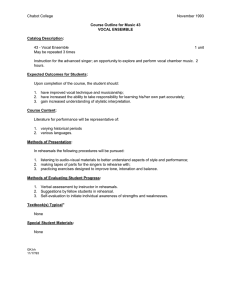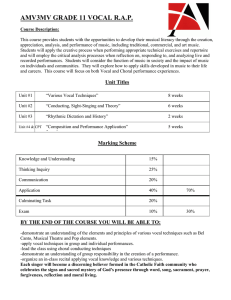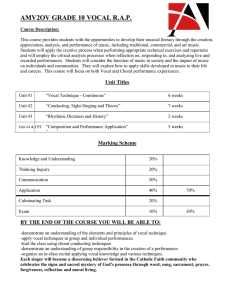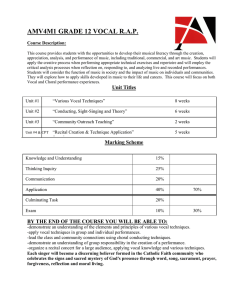MADISON PUBLIC SCHOOLS Chorus 9-12 Madison High School
advertisement
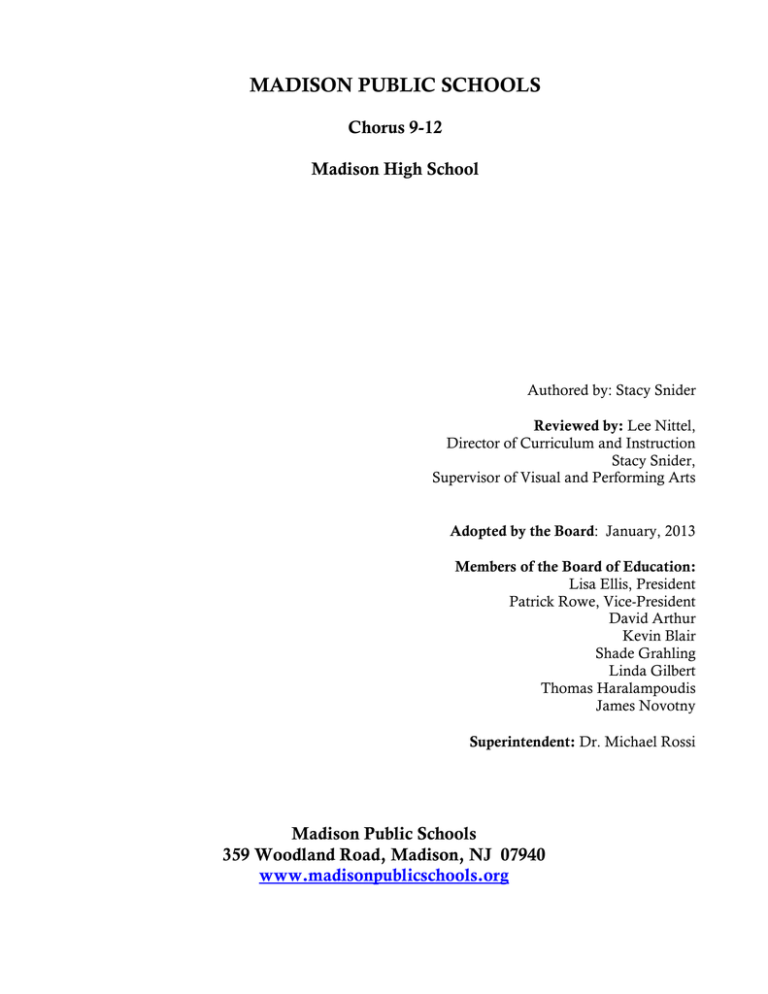
MADISON PUBLIC SCHOOLS Chorus 9-12 Madison High School Authored by: Stacy Snider Reviewed by: Lee Nittel, Director of Curriculum and Instruction Stacy Snider, Supervisor of Visual and Performing Arts Adopted by the Board: January, 2013 Members of the Board of Education: Lisa Ellis, President Patrick Rowe, Vice-President David Arthur Kevin Blair Shade Grahling Linda Gilbert Thomas Haralampoudis James Novotny Superintendent: Dr. Michael Rossi Madison Public Schools 359 Woodland Road, Madison, NJ 07940 www.madisonpublicschools.org I. OVERVIEW The High School Vocal Music Program is open to any student in grades 9-12. The intent of the program is to introduce and expose students to all aspects of vocal music, providing a forum in which they will learn to participate in, observe, critique, and appreciate the different styles of vocal music. The intent of the program is as follows: • • • • To provide students with the skills necessary to achieve an efficient and healthy vocal tone To provide students with the skills necessary to read, understand, critique, rehearse, and perform the many styles and genres of vocal music of different cultures as well as their own To ensure that students enjoy and appreciate singing in a group with their peers and bringing this musical experience into the lives of audience members To provide students with the musical experience necessary in becoming an active participant in and a patron of vocal music and fine arts The activities and materials are suggestions of methods, techniques, and performance events. The material may be expanded upon or adjusted according to student interest and as new music is written and published. Each unit contains core curriculum material according to the New Jersey Core Curriculum Content Standards for Visual and Performing Arts (revised). This material should be expanded upon and adjusted according to the needs of each individual class/student. II. STUDENT OUTCOMES (Linked to the NJ Core Curriculum Standards) Specific content standards addressed include: 1.1 1.2 1.3 1.4 Creative Process History of Arts and Culture Performance Aesthetic Response and Critique Methodologies The students will demonstrate the ability to: 1. Sing with proper breathing technique. 2. Sing with correct and most efficient vocal technique. 3. Sight-read and sight-sing using “solfeggio” syllables at an appropriate pace for each grade level. 4. Develop and expand upon knowledge of basic music theory. 5. Sing with correct intonation, and with balance and blend that is appropriate for choral singing. 6. Understand and appreciate all types of choral works, including works from their own culture and time as well as works from different cultures and with different historical influences. 7. Become aware of all aspects of choral/vocal music (to include critique), be it on the page, while singing or listening to live music, or while listening to a recorded piece. 8. Employ correct rehearsal and performance techniques and behavior 9. Prepare and perform their specific part of a vocal composition. 10. Develop an awareness of their own individual contribution to the musical goals of their group. 11. Eventually develop an interest in making vocal music a part of their lives, whether it is in a college group, community group, or professional group. III. ESSENTIAL CONCEPTS Unit 1: Introduction to Basic Principles of Singing/Sight Reading A. Posture Objective: Students will learn and demonstrate correct singing posture while sitting and standing. Activities: B. Breathing Objective: Students will learn and demonstrate proper breathing for singing, which involves a long, low intake and an exhale which will fortify tone by using the diaphragmatic muscles. Activities: C. Tone a. Teacher modeling for students. b. Specific exercises geared toward proper singing posture. c. Students monitoring each other. a. Teacher modeling for students. b. Various group and individual exercises. Objective: Students will strive for a tone which is free, efficient, and possesses the proper blend of room and ring. Activities: a. Various vocal warm-ups/exercises with different vowel/consonant sounds. b. Teacher and student modeling and critique c. Listening to recorded examples of both correct and incorrect tone production and comparing the two. D. Intonation/Blend Objective: Students will learn to sing with good intonation and with an effective choral blend. Activities: E. Diction/Musicality a. Specific exercises designed for intonation and for blending. b. Listening to recorded examples of both professional and amateur groups to critique intonation and blend. Objective: Students will learn and use proper diction for singing, and will strive to develop awareness of musicality in terms of phrasing, balance, intent, and style of a particular piece. Activities: a. Students will learn through teacher modeling. b. Specific vocal, breath, and acting exercises. Unit 2: Development of Efficient Vocal Technique and Sight-Singing A. Rhythm Objective: Students will learn to say and tap rhythms using all note and rest values in basic time signatures. Activities: B. Basic Notation Objective: Students will develop an understanding of standard notation symbols for pitch, rhythm, key signatures, dynamics, tempo, and expression. Activities: C. Sight-Singing a. Use teacher-made rhythm sheets. b. Examples written on the board. c. Use specific examples from choral pieces. a. Use teacher-made hand-outs and examples written on the board. b. Work with specific examples from the season’s repertoire. Objective: Students will learn to sight-read and sight-sing music through increasing their knowledge of intervals and their use of solfeggio. Activities: a. Teacher hand-outs, examples written on the board, and studentmade examples. b. Ear training exercises using piano. c. Sight-singing of new choral pieces. Unit 3: Rehearsal Technique A. Rehearsal Style Objective: Students will understand and demonstrate the ability to rehearse music in a productive and professional manner. Activities: B. Attendance/Punctuality a. Clearly defined classroom rules. b. Classroom discussion and student practice. c. Teacher monitoring and adjusting specific rehearsal techniques. Objective: Students will learn the importance of regular attendance and punctuality and incorporate these habits not only in chorus class, but also into their daily routines in general. Activities: . a. Both students and teacher will develop specific rules. b. Classroom discussion and repeated practice. Unit 4: Performance A. Professionalism Unit 5: Repertoire Objective: Students will learn the importance of proper concert attire, behavior, and respectfulness while performing and while attending a concert. Activities: a. Classroom discussion resulting in a clear understanding of these principles. b. Observation and critique of other ensembles. c. Detailed student/teacher-made definition of what it is to respect one another on stage and in an audience, and practice in order to achieve this. A. Music of Different Styles Objective: Students will learn to sing music in different meters and Levels of Difficulty tonalities. Activities: B. Cultural and Historical Awareness a. Hand-outs, discussion of different music styles. b. Listening to recorded examples. Objective: Students will achieve an awareness of music of different cultures and historical periods. Activities: a. Class discussion and recorded examples of these types of music. b. Specific activities geared towards understanding differences in the music of different cultures and historical periods. c. Rehearsal and performance of the music of different cultures and specific historical periods. d. Discussion of each piece and the ways in which we can relate to it on a personal level. Note: All activities will be carried out by the entire ensemble, small ensemble groups, or on an individual basis in order to vary the involvement for the student, to concentrate on the individual needs of each student or on the goals of each individual group, and in order to best utilize materials, time, and facilities. Specific activities will include warm-up exercises, work on music theory, development of vocal technique, and performances in school assemblies, choral festivals, evening performances, and community events. Rehearsal, critique, and performance of music of various periods and styles will be ongoing throughout the course. All students will be required to attend all classes as well as extra rehearsals, which will be scheduled in advance. All students are also required to attend all assemblies and concerts. Students will also be provided with the opportunity to rehearse for and to audition for musical events outside of school such as Regional Chorus, All-State Chorus, All-Eastern Chorus, and various other vocal/theatrical programs in the surrounding area. IV. EVALUATION Each student’s grade will be based on: 1. 2. 3. 4. 5. Attendance at all scheduled rehearsals and concerts. Written quizzes and tests. Small group vocal tests. Homework assignments. Student participation and preparedness. Specific grading percentages should be determined by the teacher and distributed to the students and parents in September or when a student first enrolls in the class. The numerical percentages will be converted to a letter grade. Students also have the option to enroll in all vocal groups on a pass/fail basis. V. REQUIRED RESOURCES Student Texts 1. Elementary, Intermediate, and Advanced books for each voice part (G. Schirmer) 2. Fifteen Two-Part Exercises - Kodaly 333 Elementary Exercises – Young Bicinia Hongarica – Young (All Published by Boosey and Hawkes) 3. Melodin – S. W. Cole (Oliver Ditson Co.) Choral Music 1. 2. 3. 4. Music of various periods and styles. Music for a specific rhythm/sight-singing exercise. Music to be performed in assemblies, festivals, and concerts. Music to be used for auditions for various out-of-class musical activities. Recordings 1. Recordings of works being rehearsed. 2. Recordings of artists demonstrating specific vocal technique in various styles. VI. SCOPE AND SEQUENCE I. INTRODUCTION TO BASIC PRINCIPLES OF SINGING/SIGHT-READING (September) A. Posture B. Breathing C. Tone D. Diction and Musicality E. Vocalises to expand range and improve tone and flexibility F. Review of basic theory (written and sung) G. Introduction to solfeggio H. Listen to solo artists and choral groups for critique I. Vocal maintenance II. DEVELOPMENT OF EFFICIENT VOCAL TECHNIQUE AND SIGHTSINGING (October and November) A. Continue to develop skills of Unit I B. “Room Versus Ring” theory of efficient vocal production C. Specific work on intonation and blend D. Become familiar with the music required for Regional and All-State Chorus auditions E. Rehearse music to be performed using solfeggio syllables and then words III. REHEARSAL TECHNIQUE (December) A. Continue to develop skills of Units I and II B. Discuss “intent” of each piece and how to communicate it to an audience C. Rehearse music to be performed, using the full range of vocal technique, dynamics, and phrasing D. Perform evening Holiday concert IV. PERFORMANCE TECHNIQUE (January through April) A. Continue to develop and expand skills of previous units B. Development of more advanced vocal technique for both choral and solo singing. C. Rehearse music to be performed. D. Prepare for All-State and Regional Chorus auditions E. Perform music at Festival and Spring Concert V. REPERTOIRE (May and June) A. Continue to develop and expand skills of previous units B. Study music of different styles and of different levels of difficulty C. Develop a cultural and historical awareness of music D. Rehearse music to be performed at Spring Concert and Graduation E. Perform music at Spring Concert and at Graduation
